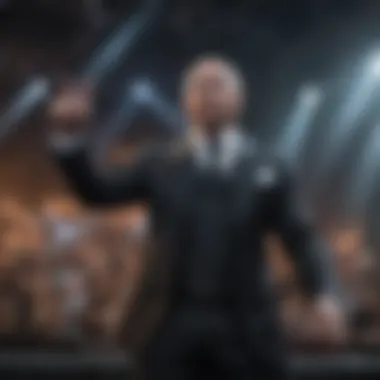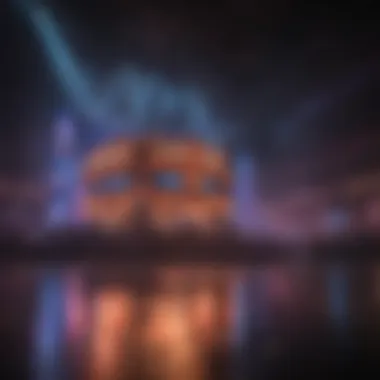Experience the Thrill of Pitbull Live at Hard Rock Atlantic City


Intro
Pitbull, the man often referred to as "Mr. Worldwide," brings a unique blend of high-energy music and captivating stage presence that leaves his audience buzzing long after the applause fades. The atmosphere during his performances, especially at renowned venues like Hard Rock Atlantic City, is electric. This isn't just another concert; it's a cultural event, a celebration of music that resonates deeply with fans from all walks of life.
In this article, we aim to peel back the layers of Pitbull's live show at Hard Rock to understand its various elements. From the meticulous planning that turns a stage into a vibrant spectacle, to the emotional connections forged in the crowd, every component plays a role in crafting an unforgettable experience. We will discuss how live performances are not just a trend, but an essential aspect of the modern entertainment landscape, creating lasting memories and connections that transcend the music itself.
Dive into the heart of the performance, and let's unpack what makes a Pitbull concert so special. Whether you're a fan of his infectious beats or simply curious about the live music scene, there's much to discover in the lively atmosphere that surrounds his shows.
Join us as we explore the ingredients that create this unique blend of excitement, emotion, and sheer entertainment.
The Venue: Hard Rock Atlantic City
The Hard Rock Atlantic City isn't just a venue; it's a landmark pulsating with history and energy, playing a vital role in the tapestry of contemporary live performances like Pitbull's concert. Here, where entertainment meets sophistication, the focus transcends the stage. This venue acts as a nexus for diverse influences and styles in music and culture, serving not just as a space for artists but also as a communal ground for fans to share an experience that’s larger than life.
History and Development
The tale of Hard Rock Atlantic City begins in the early days of the Atlantic City boardwalk. Built on the fringes of Atlantic's storied past, it stands as a testament to the evolution of this iconic seaside destination. Originally established in 1999, the venue has undergone numerous renovations to transform it into the entertainment powerhouse we see today. Its eclectic vibe captures the essence of the city: a mix of glamour, grit, and the unyielding pursuit of fun.
The Hard Rock brand, synonymous with music culture worldwide, has notably infused its spirit into the fabric of this venue. Visitors are greeted with memorabilia from legends stretching across decades, creating a narrative that connects current performances with the rich legacy of rock and pop music. The gradual growth of the venue mirrors the development of Atlantic City itself, making it not just a spot for concerts but a living museum of entertainment history.
Architectural Significance
From an architectural standpoint, Hard Rock Atlantic City is a sight to behold. Its design incorporates a modern aesthetic tied to the retro charm that the brand embodies. The towering building features striking elements, such as vibrant neon lights shimmering at night, beckoning both locals and tourists alike. Inside, the layout is tailored to amplify sound, ensuring that every note reverberates through the crowd.
The main performance space, adorned with state-of-the-art technology, accentuates the music while providing an intimate experience. Unlike large stadiums that can drown out individuality, this venue fosters a closeness between the artist and the audience. This intimacy is crucial, especially during high-octane performances like Pitbull's, where fans become part of the show itself, creating an engaging atmosphere that feels electric.
Cultural Hub of Entertainment
Furthermore, Hard Rock Atlantic City serves as a cultural hub that reflects the diversity of its community and the broader music scene. The venue hosts a variety of artists across genres, catering to all tastes, from rock and pop to hip-hop and beyond. This eclectic mix not only enriches the cultural landscape of Atlantic City but also fosters a sense of inclusivity among concert-goers.
An evening at the venue extends beyond the performance; it's a celebration of identity, rhythm, and shared experiences. Events like Pitbull's concert capture the essence of this cultural melting pot. The patronage of a diverse crowd showcases the universal language of music, where each individual, regardless of background, finds common ground through beats and lyrics.
"Music is what feelings sound like," and at Hard Rock Atlantic City, it sounds like a symphony of unity.
Pitbull: An Icon in Modern Music
In the vast landscape of contemporary music, few artists shine as brightly as Pitbull. Known for his charismatic stage presence and infectious energy, he encapsulates the spirit of modern pop and Latin music. Pitbull's importance in this article is not solely hinged on his music but also on his cultural significance as a unifying figure across diverse genres. He serves as a bridge, connecting different musical styles and audiences, making him a relevant icon in today’s entertainment industry.
Musical Evolution and Style
Pitbull, born Armando Christian Pérez, evolved from local Miami influences to global stardom. His journey provides a rich narrative about adaptability within the music scene. Initially rooted in hip-hop, Pitbull's style has morphed over the years, blending reggaeton, pop, dance, and even EDM. Tracks like "Give Me Everything" and "I Know You Want Me (El Aquelarre)" are prime examples of his genre-blending approach, showcasing this transformation.


His lyrics often exude themes of triumph, resilience, and celebration, resonating with listeners from all walks of life. Pitbull’s proficient use of bilingual lyrics makes his music accessible to both English and Spanish-speaking audiences, further expanding his reach. He is not just a rapper; he’s a cultural ambassador, promoting Latin music on the global stage. Through his evolution, he embodies the idea that music knows no boundaries, making each performance an occasion for unity.
Influence on Latin Music and Pop Culture
Pitbull's impact extends beyond his chart-topping hits. He has played a pivotal role in elevating Latin music within the broader pop culture narrative. By collaborating with mainstream artists like Jennifer Lopez, Enrique Iglesias, and Chris Brown, he has helped Latino rhythms penetrate the dominant pop music market.
His influence is evident through a few key elements:
- Crossover Success: Pitbull’s ability to secure spots on mainstream charts has opened doors for other Latin artists, offering them a platform to reach wider audiences.
- Cultural Representation: He actively champions Latino culture, encouraging pride in heritage while fostering a welcoming atmosphere through his music.
- Business Acumen: Apart from music, Pitbull's ventures into branding and entrepreneurship demonstrate a savvy understanding of market dynamics, further solidifying his status as a cultural icon.
The intermingling of Latin rhythms with mainstream beats in his work has not only sparked interest in Latin music but has also paved the way for future artists, creating a rich tapestry of cultural exchange. For avid fans, this cultural synergy translates into an electrifying concert experience, a celebration not just of music but of unity and diversity within the audience.
Setting the Atmosphere: Preparation for the Performance
The preparation for a performance, particularly one as lively as Pitbull's, involves a detailed orchestration of various elements that come together to create an unforgettable experience. This setting of the atmosphere serves as the backbone of any live musical event, shaping how the audience feels even before the first note is played. When it comes to staging, sound, and lighting, every detail is integral to immersing fans in the moment, contributing to both the emotional and sensory elements that define the concert.
Stage Design and Production Elements
The stage design at a Pitbull concert is not just a platform; it is a canvas painted with sound and color. From the outset, the aim is to create a space that pulsates with energy, reflecting the artist's vibrant persona. Curved screens, intricate backdrops, and multi-tiered risers can all be seen at Hard Rock Atlantic City; a reflection of how music and the performer can intertwine.
Each design choice serves a purpose—to captivate, inspire, and engage. For instance, during the performance of "Give Me Everything", the stage transforms into a stunning display of visual variety, with overlays of imagery that represents freedom and celebration.
Moreover, production elements usually include intricate choreography and live bands that complement the DJ and the rapper himself. Just like a winning hand in poker, where everything must align perfectly, the combination of stage elements and live performance must resonate to create a fluid experience that links the audience directly with the music.
Sound Engineering Techniques
Sound is the lifeblood of a concert. At Pitbull's shows, sound engineering is approached with precision, tailored to ensure that every beat resonates throughout the venue. Cutting-edge technology plays a significant role in this area. Various techniques are employed, such as using state-of-the-art sound systems and meticulous acoustics.
For example, advanced equalization makes certain that highs, mids, and lows are equally represented, while also considering the unique characteristics of the Hard Rock's interior—like its acoustically exciting structure. This prevents any feedback or echo that could distract from the quality of live performance.
In addition, soundboards often involve multiple channels, enabling engineers to adjust live audio in real time. This ensures that audience members experience a full, rich soundscape, whether they’re front and center or tucked away in the back of the venue.
Lighting and Visual Effects
Lighting is perhaps the most visual and emotive component of setting the atmosphere for Pitbull's show. As the lights dim and the anticipation builds, concertgoers know they are in for a spectacle. The combination of strategic lighting design and visual effects can elevate a performance from merely enjoyable to absolutely electrifying.
Typically, a variety of lighting techniques are deployed: spotlights that follow Pitbull's energetic movements, color washes that shift according to the tempo of the music, and strobe lights that add dramatic flair during key moments. When songs like "Timber" hit the airwaves, the venue lights up in a cascade of brightness—synced perfectly to the beats, pulling the crowd further into the experience.
Visual effects, such as projections and firework-like showcases, often complement these lighting changes, creating an atmosphere that feels larger than life. Each flash and glow acts as a visual cue, enhancing the connection between the audience and the music. Such elements ensure that fans leave the venue not just as spectators, but as part of a collective memory that ties them to Pitbull’s performance.
"Creating an unforgettable performance isn’t just about the music; it’s about crafting a multi-sensory experience that captures hearts and minds alike."
Ultimately, the preparation behind the performance encapsulates a host of meticulous details, each vital in weaving together a tapestry of sound, sight, and emotion that resonates long after the last note fades.


Audience Engagement: Connection with Fans
In the realm of live performances, few elements are as crucial as the connection between the artist and the audience. At Pitbull's electrifying concert at Hard Rock Atlantic City, this connection was palpable, underscoring the necessity for artists to actively engage with their fans. This engagement is not merely a byproduct of the performance; it shapes the event’s energy and leaves a lasting impact on attendees, inviting them to participate in a shared experience.
The atmosphere during the show transformed as the crowd surged with enthusiasm. The importance of audience participation became evident, as every shout, every cheer, and every synchronized move contributed to an exhilarating vibe. One could argue that a concert becomes a mere recital without this interplay; instead, it morphs into a vibrant celebration of sound and emotion.
The Role of Audience Participation
Audience participation often acts as the beating heart of a concert. In the case of Pitbull, who is known for his inclusive style, he rallied fans to sing along, dance, and even share in some playful banter. When attendees feel like they’re part of the show, it amplifies their enjoyment and creates memories that linger long after the final note has faded.
- Sing-alongs: Collaborative choruses transform the atmosphere. When fans join in, they become a part of the spectacle, not just passive observers.
- Call-and-response: This technique breaks the barrier between the performer and the crowd, heightening excitement. Pitbull often utilized this to keep fans energized and engaged.
- Physical movement: Choreographed dances or simple gestures encourage everyone to let loose. The simple act of dancing together can bridge generational gaps, uniting attendees in a collective experience.
This level of involvement tends to create a communal spirit. Fans feel empowered to express their joy, which, in turn, inspires the performer to elevate the energy even further. It's a cyclical relationship that reinforces why live music remains relevant and cherished.
Impact of Social Media on Live Performances
In our digital age, social media serves as an unprecedented tool for enhancing the live concert experience. At Pitbull’s performance, many fans were not only present physically but were also virtually connected through platforms like Instagram and Twitter, sharing their excitement with followers.
Social media's influence can be summarized in a few key points:
- Real-time updates: Fans broadcast their experiences as they happen, creating a buzz that can draw in others who might not have initially intended to attend. A hastily shot video can evoke FOMO (fear of missing out) in potential concert-goers.
- Interactive elements: Events often have designated hashtags encouraging fans to post their experiences and photos. This fosters a sense of community far beyond the concert venue. Pitbull fans shared snippets of performances, capturing moments not just for their friends but for a global audience.
- Memorable moments captured: Social media allows for the preservation of unique experiences, like Pitbull's spontaneous interactions with fans. Every shared story becomes part of the ongoing narrative, blending into the larger musical tapestry.
Cultural Impact of Live Music in Contemporary Society
Live music is more than just a form of entertainment; it serves as a vital cultural pulse that connects individuals and communities. In the context of contemporary society, particularly around performances like Pitbull's at the Hard Rock Atlantic City, the cultural impact extends far beyond the initial thrill of the show. This touchstone of live music brings people together, forging links that resonate on both personal and societal levels.
The experience of attending a concert cultivates a unique sense of belonging. Whether one is a devoted fan or a casual listener, the electric atmosphere shared among attendees is palpable. People from varied backgrounds converge in a unified space, drawn together by rhythm and melody, fostering a sense of camaraderie that is hard to replicate in other contexts. This communal experience often results in friendships, memorable connections or a shared love for the artist's work, thus reinforcing the notion of music as a social connector.
Music as a Form of Social Connection
Music facilitates communication on a level that words often cannot. Live performances act as a bridge of understanding across diverse cultures and demographics. For instance, during Pitbull's concert, his blend of English and Spanish lyrics resonates with a wide audience, inviting everyone to partake in the experience, regardless of their language or heritage.
Moreover, the communal act of experiencing live music can be likened to participating in a collective ritual. Audiences cheer, sing along, and dance in synchrony, establishing a temporary society based on shared enthusiasms. In these moments, individuals feel less isolated, as they are part of something larger than themselves. This ability to unite people from all walks of life underscores music's role as a significant cultural artifact which rallies communities together and stimulates social conversations.
“Live music is the ultimate connector—it transcends barriers and unites the soul.”
Economic Benefits of Live Events
The economic implications of live events like concerts have profound significance extending to local economies and beyond. Shows at places like the Hard Rock Atlantic City attract countless attendees, which in turn injects considerable revenue into the area. Local businesses—such as restaurants, hotels, and shops—benefit substantially from the influx of concert-goers, creating a ripple effect that stimulates economic activity. For instance, an uptick in diners or room bookings depends largely on concert events, putting money back into the local economy.
Additionally, live music contributes to job creation, not just within the entertainment sector, but across various industries related to it. From staging and sound engineering to security and catering, there is an expansive network of professionals involved in making live performances successful.


The long-term economic benefits of such gatherings can also lead to urban development and revitalization, as cities and venues recognize the draw of live events. Investments in infrastructure, improvements to accessibility and enhancements in local amenities are often spurred by the need to attract more visitors for shows. These enhancements can create lasting value for both residents and tourists alike.
In summary, the cultural impact of live music in contemporary society is multi-faceted. It not only connects individuals through shared experiences but also provides crucial economic benefits that can uplift communities. By exploring these aspects, we gain a deeper understanding of the critical role live performances play in our connected world.
Post-Performance Reflections
Reflecting on a concert's aftermath is an essential element that often highlights the emotional and cultural significance of the event. After the grand performance by Pitbull at Hard Rock Atlantic City, both attendees and artists have a chance to process the experience. Not only does this time serve to savor the memories made but also offers insights into the fervor generated throughout the night.
These reflections can shape future concerts, influence ongoing artist development, and perhaps even guide venue practices. Shared moments not only solidify a bond between the performer and audience but also foster a communal narrative that resonates across social platforms.
Memorable Moments from the Concert
Every concert has its poignant highlights. For Pitbull’s performance, the audience witnessed not just a show but a series of unforgettable events that sparked joy and excitement alike.
- Surprise Guest Appearances: One moment that stood out was the unexpected entrance of a well-known collaborator who joined Pitbull onstage. This electrified the crowd, causing an eruption of cheers and shared excitement.
- Dazzling Visuals: The moment when the visual effects turned the stage into a vibrant tapestry of colors, perfectly synchronized with the beats, left attendees awestruck.
- Audience Interaction: Pitbull’s ability to engage with the crowd created a sense of intimacy amid the grand spectacle. Guests recalled moments when he pointed directly to fans, inviting them to sing along, fostering a sense of belonging and participation.
Each of these moments contributed to an enchanting atmosphere, leaving impressions that would linger long after the last encore.
Audience Testimonials and Experiences
The experience of a concert is often subjective; hearing directly from the audience provides a two-way street of reflection. Attendees at Pitbull's show shared their thoughts on social media and forums, creating a tapestry of experiences that highlighted the concert's impact.
- Shared Excitement: Many fans described the exhilarating atmosphere, where the energy felt palpable. Comments flew around on platforms like Reddit, where individuals described their disbelief at being so close to an idol.
- Emotional Resonance: Attendees spoke about how certain songs resonated deeply with their personal experiences, fostering a sense of connection beyond the music. "Tonight was that moment where I felt understood," one fan noted on Facebook.
- Overall Event Appreciation: The feedback not only praised Pitbull’s performance but also expressed gratitude towards the venue's organization, further adding layers to the experience.
Understanding the audience's takeaway from the concert is crucial because it illuminates the concert's role in fostering cultural connections and shared moments in modern society.
Future of Live Music: Trends and Innovations
The realm of live music isn't simply about the artists—that's just the icing on the cake. It’s a dynamic landscape continually evolving with new trends and innovations shaping how audiences engage with performances. As we dive deeper into this topic, it’s essential to understand how technology, shifting audience preferences, and innovative concert formats are steering the future of live music. This evolution not only influences the way artists present their work but also affects the overall experience and connection with the audience.
Technological Advancements in Concert Productions
In today’s digital age, technology is the name of the game. The integration of cutting-edge tech in concert productions has given rise to immersive environments that captivate attendees. Think about it for a second—high-definition LED screens, advanced sound systems, and augmented reality effects aren't just a nice-to-have anymore; they’re becoming a fundamental part of live performances.
Imagine stepping into a venue where the stage is not just a platform but a fully interactive playground. For instance, artists like Pitbull leverage responsive light shows that synchronize with the beats of the music, creating a multisensory experience that leaves fans buzzing with excitement. Moreover, innovations such as drone light shows are gaining traction, allowing for aerial displays that add a mesmerizing aesthetic to performances. This is not just changing how concerts look; it also transforms how artists can tell stories through their music.
Additionally, virtual and augmented reality technologies are allowing fans to enjoy performances from the comfort of their homes while still feeling part of the action. With these tools, fans can experience concerts as if they were right in the middle of the crowd, which is particularly appealing for those who cannot travel. If it's innovation you’re after, the digital age is certainly serving it up hot!
The Shift Towards Hybrid Events
The term "hybrid events" pops up frequently in discussions about the future of live performances, and for a good reason. In the wake of recent global events, the music industry has had to adapt quickly. No longer are live events limited to traditional in-person experiences; they have expanded to include virtual attendance options that cater to audiences around the globe.
Hybrid concerts offer a unique blend of physical and digital engagement. A prime example would be hosting a live performance in a venue while streaming it simultaneously online. This not only opens up the show to fans who may be unable to travel but creates a more inclusive environment.
"The concert experience is no longer confined to the four walls of a venue; it reaches far beyond, creating opportunities for engagement on a global scale."
Let’s delve into a few noteworthy advantages:
- Broader Reach: Artists can engage fans from different countries, breaking geographical barriers.
- Enhanced Engagement: Fans tuning in virtually can interact through comments and social media platforms, making them feel like they are part of the live experience.
- Flexible Formats: Organizers can design events that cater to in-person and online audiences, ensuring that everyone can participate in whatever way suits them best.















